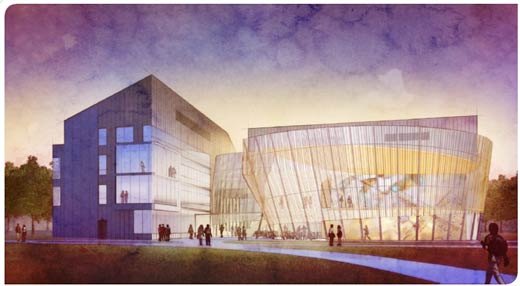
In speaking with Dr. Douglas Perry, the Dean of the
College of Informatics, it only takes a matter of time before one begins to share his excitement for
Northern Kentucky University's new $50.8 million Center for Informatics. Drawings show a state-of-the-art facility that will serve as both a new home for the College of Informatics as well as a gateway to the campus' West Quad.
The 110,000-square-foot facility, designed by lead architect
Goody Clancy and local architecture firm
McGill Smith Punshon Inc., is made up of a central Informatics Common and "digitorium," flanked on two sides by four-story loft-style academic buildings.
One enters the structure through the Informatics Common, designed to serve as an intersection between the social and digital worlds contained within the center. This space will house a "genius bar", complete with a multi-discipline technology help desk, research flex space, and a café.
Within the Informatics Common sits the impressive two-story glass digitorium, the fully reconfigurable technological heart of the center equipped with audio/visual technology using high-quality LED, digital projection, and intelligent digital displays that allow users to watch, interact with, create and share information. The digitorium's transparent skin is designed to reflect the center's purpose by allowing those outside to witness human interaction, the most basic – yet most complex – of information sharing systems.
"With the digitorium we are going to be able to create or recreate anything digital including simulations of war rooms, gaming contests, 3D film festivals, mercantile trading houses or even a performance space," says Dr. Perry.
What does the College of Informatics need with a performance space? Dr. Perry is happy to explain that his vision for informatics goes well beyond the "hardcore bit-level computer science." Although that research is important, Dr. Perry wants to reach much further… "all the way to a whole human-affected domain – including writing, communication, music, performance, even dance."
Preliminary conversations have taken place with area arts leaders including Cincinnati Ballet CEO and Artistic Director, Victoria Morgan about using the College's resources in new and different ways.
"The digitorium will be saturated with high definition cameras that can take images of a performance, synthesize, render into a new image, and project onto the digitorium wall, all in real time. The artistic possibilities are endless," says Dr. Perry.
Opening things we take for granted into a realm of endless possibility is at the very heart of the study of informatics. Dr. Perry continues, "We want to transcend the college to offer something so unique that it will draw in as many people as possible. I want people to walk in and understand immediately what informatics could mean to them."
Lining the Informatics Common sits a pair of glass and metal lofts housing classrooms and labs arranged on the lower two floors, administrative functions stacked on the third floor, and faculty offices on the fourth floor.
Construction of the Center for Informatics is expected to begin within the next two months, with completion occurring by July 2010.
The Kentucky legislature has approved $35.5 million for the new center, with the remainder being funded by a mix of grants and private, government, and corporate funding.
"Currently there are very few colleges of informatics in the country," says Dr. Perry. In fact NKU can boast it has one of less than a dozen like it around the nation.
"The University conducted a study five years ago where they looked at the surrounding economy and area and said, 'where can we go from here?'"
The study showed that NKU was already graduating a number of students in the informatics field even without a program dedicated to it.
"The real reason we got the program started was because of the surrounding business community," says Perry.
It turns out Northern Kentucky's industries and businesses possess a very real and practical need for talent honed in programs such as these. "85 percent of our graduates stay right here," says Perry who believes the new facility will help supply the skilled workforce needed for the region's information economy by attracting and retaining artists, musicians, entrepreneurs, and scientists.
Currently a leader in Kentucky's e-health network through the modernization of the delivery of health care through technology, the college is looking to expand its study of electronic information to other disciplines. A $2 million investment into a virtual "cave" will open doors to a number of area companies wanting to perform simulated market research. "Most companies, even the larger ones, can’t make that kind of investment into that kind of technology," says Dr. Perry. "We'll be the only facility in the region that will be able to offer this kind of space to a wide array of companies."
Writer: Kevin LeMaster and Jeff Syroney
Source: Northern Kentucky University College of Informatics
Rendering provided